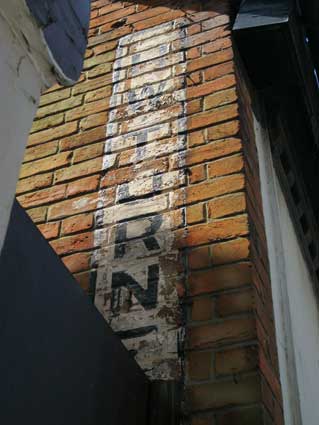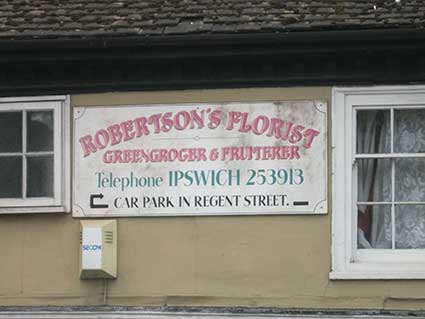

 2000 image
2000 image 2012 image
2012 image 1902 map
1902 map
 Photo courtesy The Ipswich Society
Photo courtesy The Ipswich Society| Source/date |
Entry details |
Notes |
| Stevens Directory 1881 |
104? 102 Brown, J. bricklayer Wharn, Wm. cutler -Here is St Helens Court- |
No entry for
104 |
| Stevens 1885 |
100 Water Lilly Inn 102 Brown, John G. bricklayer 104 Webber, W. brickmaker |
Brickmaker |
| Stevens 1894 |
102 Brown, John 104 Foster, Arthur boot repairer -Here is St Helens Court- |
Boot repairer |
| Kelly’s 1906 |
102 Taylor, Walter
greengrocer -Here is St Helens Court- 106 Harvey, John Robert oil man -Here is St Helens Place- |
First mention of a long
line of greengrocers at no. 102 |
| Kelly’s 1909 |
102 Cross, A.A.
greengrocer -Here is St Helens Court- 106 Harvey, John Robert oil man |
|
| Kelly’s 1910 |
102 Cross, A.A.
greengrocer -Here is St Helens Court- 104 Hazell, Joseph S. hair dresser 106 Harvey, John Robert oil man |
Hair dresser |
| Kelly’s 1912 |
102 Cross, A.A.
greengrocer -Here is St Helens Court- 104 Skilton, Alfred John hair dresser 106 Harvey, John Robert oil man |
|
| K 1913-1921 |
(ditto) |
|
| K 1922 |
102 Rash, John greengrocer -Here is St Helens Court- 104 104 Skilton, A. J. hair dresser |
|
| K 1923-1926 |
(ditto) | |
| K 1927 |
102 Rash, John greengrocer -Here is St Helens Court- -Here is St Helens Place- 108 Bishop, Wm. B. pork butcher |
|
| K 1928 |
102 Rash, John greengrocer -Here is St Helens Court- -Here is St Helens Place- 106 Ross, Jas. hardware stores |
|
| K 1929 |
102 Rash, John greengrocer -Here is St Helens Court- -Here is St Helens Place- 104 Groom, Fredl. confctnr. |
Confectioner |
| K 1930 |
102 Rash, John greengrocer -Here is St Helens Court- -Here is St Helens Place- 106 Harvey, Mrs E. outfitter |
|
| K 1931 |
102 Abbott, Arthur Wm.
greengrocer -Here is St Helens Court- 104 Sawyer, Walter confctnr. |
|
| K 1932 |
(ditto) |
|
| K 1933 |
102 Abbott, Mrs A. W.
greengrocer 104 Sawyer, Walter confctnr. |
No break 104-102 |
| K 1934-1937 |
(ditto) |
|
| K 1938 |
(ditto) but -Here is St Helens Place- is between 106 and 108 |
|
| K 1939 |
(ditto) |
|
| K 1940 |
102 Abbott, Mrs L.
greengrocer 104 Clarke, Jn. Tobccnst. |
Tobacconist |
| K 1941 |
102 Barker, Mrs A.W.
greengrocer 104 Clarke, Jn. tobacconist |
|
| K 1943, '47, '49 |
(ditto) |
|
| K 1952 |
102 Abbott, Mrs L.
greengrocer 104 TURNER, H.W. electrical engineer. Tel. 2365 |
H.W. TURNER (sign on
front edge of 104 shop) |
| K 1956 |
102 Abbott, D.A.
greengrocer 108 |
104, 106? |
| K 1960 |
102 Abbott, D.A.
greengrocer 104 Turner, H.W. eletrcl. Contrctr. |
|
| K 1962-3 |
102 Abbott, D.A.
greengrocer 104 Turner, H.W. (Ipswich) Ltd. eletrcl. contrctr. |
|
| K 1964-5 |
(ditto) |
|
| K 1966 |
102 Robertson, N.G.
fruiterer & greengrocer 104 Turner, H.W. (Ipswich) Ltd. eletrcl. contrctr. |
Neville Robertson starts
his business which he ran from no. 102 until he retired in 1998(?) |
| Kelly’s 1967-1975 |
(ditto) |
No later Kelly’s
directories found |


 2016 images
2016 images

 1980 image courtesy The Ipswich Society
1980 image courtesy The Ipswich Society 1970s
photograph courtesy The Ipswich Society
1970s
photograph courtesy The Ipswich Society 2014 image
2014 image 2012 images
2012 images
 Courtesy Ipswich
Society Image Archive
Courtesy Ipswich
Society Image Archive 2004 image
2004 image